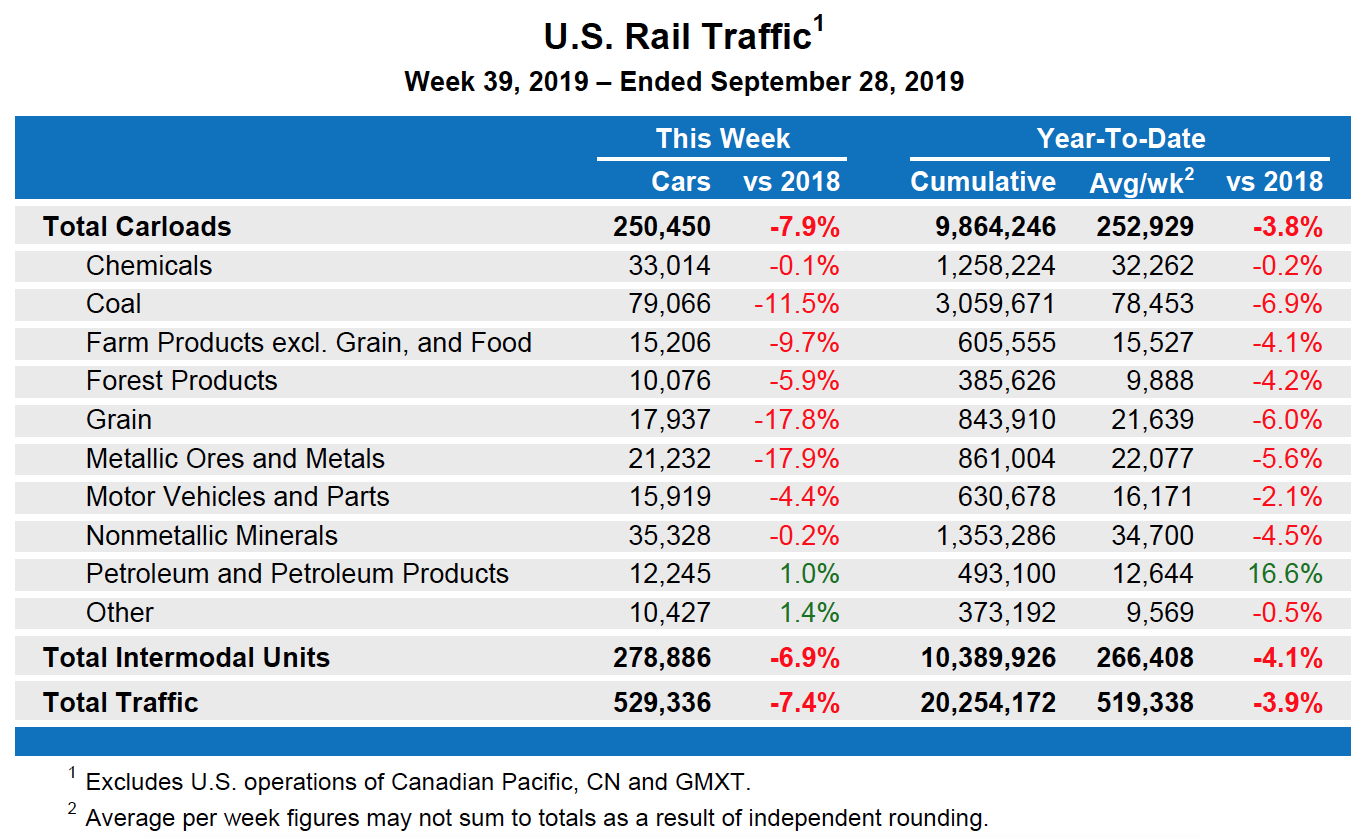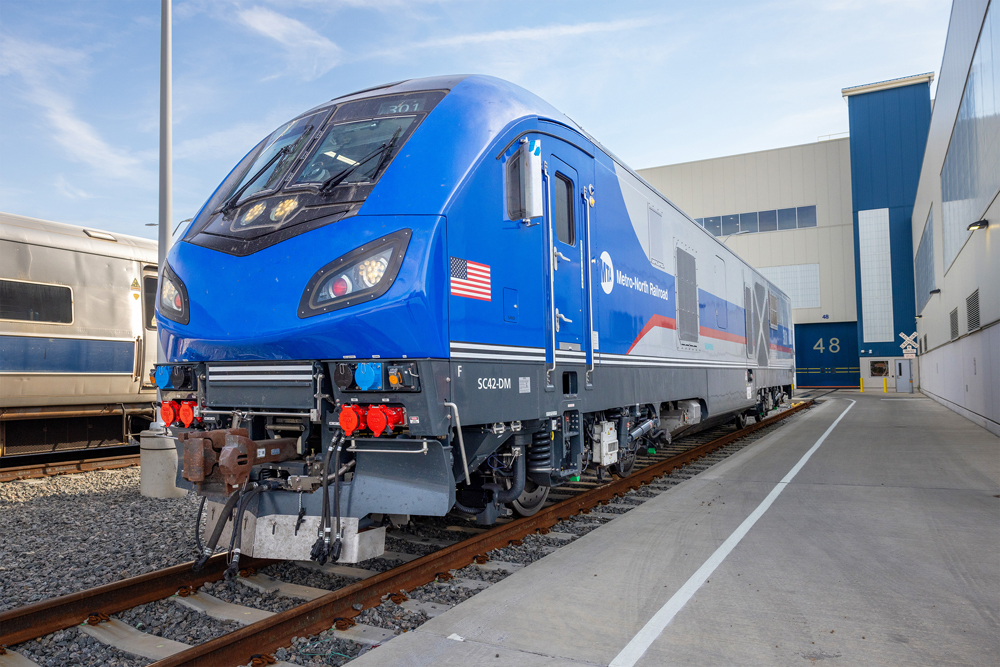U.S. railroads originated 992,542 carloads in Sept. 2019, down 7%, or 74,172 carloads, from Sept. 2018. U.S. railroads also originated 1,061,483 containers and trailers in Sept. 2019, down 5.9%, or 65,989 units, from the same month last year. Combined U.S. carload and intermodal originations in Sept. 2019 were 2,054,025, down 6.4%, or 140,161 carloads and intermodal units from Sept. 2018.
In Sept. 2019, six of the 20 carload commodity categories tracked by the AAR each month saw carload gains compared with Sept. 2018. These included: stone, clay & glass products, up 1,110 carloads or 3.4%; non-metallic minerals, up 944 carloads or 5.9%; and primary forest products, up 429 carloads or 10.1%. Commodities that saw declines in Sept. 2019 from Sept. 2018 included: coal, down 30,361 carloads or 8.7%; grain, down 13,684 carloads or 15.8%; and crushed stone, sand & gravel, down 7,328 carloads or 7.5%.
“In 2019, railroads are facing multi-pronged challenges,” said AAR Senior Vice President John T. Gray. “Fundamental long-term structural changes — including the continued erosion of coal markets; growth in the domestic intermodal and chemical sectors; and the current disruptions to manufacturing, agricultural, and international intermodal markets stemming from trade uncertainty and the evolution of consumer purchasing practices — have all required adaptation and renewed focus on basic railroad management and operational principles. That said, the industry’s ultimate goal will remain what it’s always been: providing safe, cost-effective transportation that meets the evolving demands of our customers’ markets, now and in the future.”
Excluding coal, carloads were down 43,811 carloads, or 6.1%, in Sept. 2019 from Sept. 2018. Excluding coal and grain, carloads were down 30,127 carloads, or 4.8%.
Total U.S. carload traffic for the first nine months of 2019 was 9,864,246 carloads, down 3.8%, or 384,418 carloads, from the same period last year; and 10,389,926 intermodal units, down 4.1%, or 441,953 containers and trailers, from last year.
Total combined U.S. traffic for the first 39 weeks of 2019 was 20,254,172 carloads and intermodal units, a decrease of 3.9% compared to last year.
Week Ending Sept. 28, 2019
Total U.S. weekly rail traffic was 529,336 carloads and intermodal units, down 7.4% compared with the same week last year.
Total carloads for the week ending Sept. 28 were 250,450 carloads, down 7.9% compared with the same week in 2018, while U.S. weekly intermodal volume was 278,886 containers and trailers, down 6.9% compared to 2018.
Two of the 10 carload commodity groups posted an increase compared with the same week in 2018. They were miscellaneous carloads, up 139 carloads, to 10,427; and petroleum and petroleum products, up 119 carloads, to 12,245. Commodity groups that posted decreases compared with the same week in 2018 included coal, down 10,252 carloads, to 79,066; metallic ores and metals, down 4,641 carloads, to 21,232; and grain, down 3,880 carloads, to 17,937.
North American rail volume for the week ending Sept. 28, 2019, on 12 reporting U.S., Canadian, and Mexican railroads totaled 356,053 carloads, down 6.8% compared with the same week last year, and 373,400 intermodal units, down 4.8% compared with last year. Total combined weekly rail traffic in North America was 729,453 carloads and intermodal units, down 5.8%. North American rail volume for the first 39 weeks of 2019 was 27,647,819 carloads and intermodal units, down 2.8% compared with 2018.
Canadian railroads reported 83,791 carloads for the week, down 5.8%, and 73,658 intermodal units, down 0.3% compared with the same week in 2018. For the first 39 weeks of 2019, Canadian railroads reported cumulative rail traffic volume of 5,924,320 carloads, containers and trailers, up 1.4%.
Mexican railroads reported 21,812 carloads for the week, up 3.9% compared with the same week last year, and 20,856 intermodal units, up 11.6%. Cumulative volume on Mexican railroads for the first 39 weeks of 2019 was 1,469,327 carloads and intermodal containers and trailers, down 2.9% from the same point last year.
— An Association of American Railroads news release. Oct. 2, 2019














Jim is correct in his assessment. A good example would be the old Chicago and Northwestern. A prime example of railroad suicide. CSX is currently following the same path. In the bigger picture, the decline in rail traffic portends a recession.
They are running away business and then redrawing the line in the sand time and time again. There are communities nationwide which no longer receive anything by rail. Never seen any business so eager to give in to the competition.